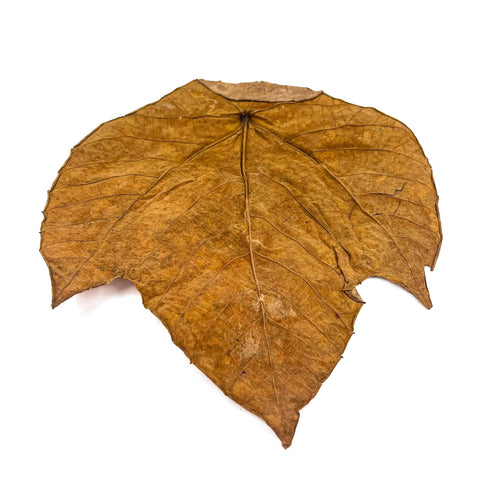Macaranga Leaves Are The Most Acidic Leaf We Offer
Many of us are familiar with the classic botanical choices – catappa leaves, alder cones, oak leaves, etc. But, say you had a specific ecosystem in mind to recreate. Today, let’s explore a unique option that is perfect for re-creating Indonesian biotopes, macaranga leaves. If you have a wild-type betta native to Sumatra or Indonesia, such as betta rubra, betta Hendra, or betta Persephone, this is the botanical for you!
You may have seen this wonderful blackwater biotope leaf across youtube by popular biotope aquarists using these macaranga leaves and an unimaginable amount of peat to recreate peat swamp habitats for parosphromenus, gouramis, rasboras, and our beloved bettas. So why have macaranga leaves not been more popular here in our blackwater hobby? For one, these plants are crawling with ants, but more on that later…
What are Macaranga Triloba leaves?
Macaranga triloba is a broadleaf tropical tree that is part of the family Euphorbiaceae (spurges). Familiar favorites such as poinsettias, crotons, and even cassavas are also a part of the spurge family. Macaranga trees are pioneer species, one of the first plant species to begin recolonizing rainforest areas that have been cleared or burned and harbor a diverse ecosystem of insects. Decoctions made from different parts of Macaranga triloba have been used by native peoples to treat injuries and diseases which originally sparked our interest in their use as a prime leaf for blackwater biotopes.
The Native Ecosystem of the Macaranga Tree
Macaranga triloba is primarily found on the island of Sumatra in Indonesia, especially on the western coast bordering the Indian Ocean. Some macaranga varieties can also be found in nearby Singapore. Sumatra is part of the tropical rainforest biome and is hot and humid year-round, although it is considered one of the coldest islands in Indonesia. The average daily high is 90 degrees Fahrenheit (32 C) – chilly, I know! The most rain falls in November and December, although precipitation falls every month of the year. Sumatra is also home to wild betta species that are popular in the aquarium hobby, including betta rubra.
A majority of Indonesia is covered by water. Peat swamps, mangrove forests, and wetlands cover nearly 49 million acres while rivers cover another 4 million. This explains why so many tropical fish species are found here. Okay so back to that ant thing… our macaranga leaf suppliers are real troopers. These plants host colonies of ants which protect these pioneer species from herbivorous insects in exchange for a place to live inside the hollow stems and trunks of these plants. Their collection requires a high pain tolerance because THE ANTS BITE! Luckily we devised a simple plan of rinsing down the trees with the garden hose first before collecting them.
Photo credit to Kory Aqua
Using Macaranga Leaves to Create a Blackwater Biotope
Indonesian biotopes are popular among tropical freshwater fish keepers, as many fish in the hobby come from Indonesia and the surrounding regions. In fact, Indonesia is home to over 1,300 species of freshwater fish, which is more than anywhere else in Asia! Some popular fish native to Indonesia include wild bettas, many types of gourami, clown loaches, chili rasboras, and kuhli loaches.
Macaranga leaves are a must-have if you are setting up an Indonesian biotope! You can combine them with other botanicals found in Indonesia such as sterculia pods, jambolan leaves, and jackfruit leaves. Macaranga leaves act like peat in the aquarium, allowing you to recreate the low-pH conditions of Indonesian peat swamp ecosystems (did you know that the pH can drop as low as 3 in some peat swamps?). Not to mention that many fish will exhibit interesting natural behaviors when kept in a space that mirrors their native habitats. We found that the single use of a 5” diameter macaranga leaf decreased our tap water’s pH from 7.2 down to 5.7. No other botanical, besides peat, has been strong enough to do this.
Due to their size, macaranga leaves may be better suited to larger aquarium setups. However, like most botanicals, macaranga leaves may be crushed up so you can still use them in your nano botanical method and blackwater aquariums.
How to use Macaranga Leaves with Blackwater Fish
Because they are native to Indonesia, macaranga leaves are a great choice for your betta tank. Macaranga leaves have similar benefits to catappa leaves; they produce nearly the same level of tannins and can lower your water’s pH. While wild betta species often have unique water parameter requirements, most bettas prefer dark, slightly acidic conditions. We recommend pulling out 2-3 leaves from the bag, rinsing them gently under hot tap water for 30 seconds, and then giving them a quick boil for 5 minutes. Do not worry, this only reduces their tannin content by ~10%. We recommend discarding this batch of water down the drain. From here you can let the leaves cool and then add them to the aquarium, or soak them overnight to help water-log them.
Note – If you plan to use these botanicals in your betta tank, we recommend ripping the leaves into smaller pieces before adding them to avoid overcrowding the scape.
We’ve provided these leaves to many hobbyists looking to keep bettas, but our favorite was to Kory Franco who used them in his Betta Imbellis tank. Within a day of him adding these leaves the male of the colony built an exquisite bubble nest under the leaves and there were eggs within the week.
Naturally Lower the pH of Your Aquarium With Macaranga
Nature is diverse. Creating your dream aquarium ecosystem is only limited to having the right supplies and using your imagination. If you are as passionate as we are about freshwater fish endemic to Indonesia and Southeast Asia, you're in the right place! Macaranga leaves are ideal for building an authentic Indonesian biotope. Macaranga leaves are the perfect addition to wild betta aquariums, but you can use them in any botanical method or blackwater setup. At Betta Botanicals, we love macaranga leaves for their high-tannin content, and we hope you love them, too! Good luck, and happy fishkeeping!












Inspire your friends:
Key Differences: Biotopes, Blackwater & Botanical Method Aquariums
Setting Up An Aquarium | Research, Inspiration, Life & Death
1 comment
We have lots of macaranga trees growing here in the Philippines, never thought of using them in my aquarium; I have always thought they were poisonous being part of the euphorbia family and all but maybe that’s just plant prejudice on my part😛. Unfortunately I can’t find any Macaranga triloba growing in my area, I wonder if Macaranga tanarius leaves would have the same effect🤔 .